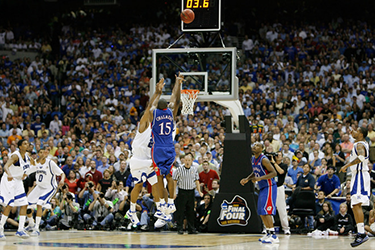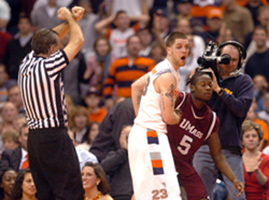- Offensive Techniques & Strategies
End of Game Strategies

End of game situations really become paramount during the end of the season when a single shot can make the difference of winning and losing along with determining a team’s playoff hopes and fate. Therefore, to be successful, teams must be prepare for end of game situations.
Basic Guidelines
When Ahead Late in the Game
The clock is your ally. Do not stop it (unless in very serious trouble). Be sure that players know how many timeouts are remaining and if they have a foul(s) to give. Being aware of the timeout and team foul situations can make the difference in winning or losing.
-
Maintain disruptive pressure defense without fouling.
Deny dribble penetration. Build cushion staying between your opponent and the basket.
Pressure all three point shots with both hands up high.
Use a half court press to defend against fast breaks and slow game tempo.
Box out and rebound. Do not allow any second efforts.
Take care of the ball offensively. Maintain proper spacing and use sharp accurate passes.
Move the ball and do not allow the opponent to stop the clock by fouling.
When Behind Late in the Game
The clock is the enemy, not the opponents. Seconds are precious. Every effort should be made to prevent time from running off the clock. By proper use of time outs and fouls the last few minutes of a game can be an eternity so don't ever give up.
Take a charge.
Create a five (5) second violation.
Steal the inbounds pass.
Give a foul.
Rebound aggressively at both ends. Putbacks and second efforts are vital.
Push the ball on offense. Be quick but do not hurry. Make successful passes.
Go strong to the basket. The opposing players usually play poor defense since they do not want to foul.
Intentionally missing a free throw
Chances are good during the season that an end of game situation will be encountered that requires the intentionally missing of a free throw; therefore, teams must be prepared for it. Intentional missing a free throw must be taught and practiced. Players must recognize and know what their assignments are on an "intentionally" missed free throw situation. Shooters must not only practice the intentional miss, they also need to be aware of the rule that the ball must hit the rim on the attempt.

Nightmares to Avoid That Will Upset Your Championship Dreams and Haunt You the Rest of Your Life.

“Failing to prepare is preparing to fail.” — Coach John Wooden
1. Not Protecting a Hard Earned Lead
When ahead late in the game the game clock becomes your ally. However, you must use it wisely. Keep it running and do not stop it (unless in very serious trouble). Coaches may elect to spread the court on offense to take time off the clock and cut down on the number of opponent’s offensive possessions. However, in doing so, be sure to continue to make basket cuts and attack the basket. Holding the ball for the sake of trying to run time off the clock will allow the defense to get more aggressive and disruptive. You must attack the basket. If the opponent tries to trap or double team, assume a 2-1-2 alignment and move the ball.
2. Watching the Ball and Not Boxing Out on a Last Shot
On last shot situations, more games are won on putbacks than on made shots. Therefore, on last shot situations, it is imperative that all defenders aggressively box out and prevent any offensive rebound, instead of watching the flight of the ball to see if it is going to be made or not.
3. Giving Up an Offensive Rebound on a Missed Free Throw
Defensively, teams should work hard to never give up an offensive rebound off a missed free throw situation during a game. Many championships are lost because of a failure to box out on free throws. Players should be well drilled in boxing out on all free throw situations. Players must also communicate to make sure that the shooter is boxed out. Pinch or double team against a really good offensive rebounder. Be determined to rebound the ball.
4. Allowing precious time to run off the clock before fouling
Hopefully, you are well prepared and in control of the game so that you will not need to resort to clock management. However, if you ever fall behind late in the game don’t give up! By using time outs and fouls, the last few minutes of a game can be an eternity. At this point in the game, the clock is your worst enemy, not the opponents. Therefore, every second counts. Do not let precious time run off the clock before fouling. If you need to foul, foul right away.
5. Not Substituting for Key Players in Must Foul Situations
When fouling to the stop the clock at the end of the game, during a timeout or free throw or defensive out of bounds situation, substitute players into the game that can afford to foul instead of losing your best players because of disqualification. Also, key players in foul trouble are reluctant to foul, allowing precious time to run off the game clock. Once a foul has been committed, stopping the clock, players in foul trouble can be quickly reinserted into the game.
6. Not Teaching and Practicing How to Foul

Most coaches assume players know how to foul. However, in reality, when a coach tell the players to foul, they will simply go out and just push or grab an opponent resulting in an intentional foul. Since the opponent gets to shoot free throws and retains ball possession, this is disastrous.
7. Fouling a Shooter
Eliminate the three point play. Giving up a three point play by fouling a player in the act of shooting is a RBP (Really Big Play). Instead of fouling a shooter and giving up a three point play, it is better to just concede the shot. Chances are that they may miss the shot. However, if they do score, all you have to do is to score on the next possession to “erase” or cancel it. If you foul the shooter and give up a three point play, you will then have to not only score on your next possession, but also come up with a defensive stop and score a second time to erase or cancel it.
8. Fouling When Ahead
Avoid fouling, especially early in shot clock, when leading late in the game. The clock is your ally - keep it running. Fouling when ahead allows the opponents to put points on the scoreboard when the clock is stopped. Fouling when ahead also eliminates the opponents need to foul or use up their value timeouts to stop the clock.
9. Not Saving Timeouts
Save your timeouts. You will need at least two at the end of a closely fought game. Force the opponent to use their time outs especially early in the game. Rather than taking a valuable time out early in the game, use substitutes to make changes and adjustments. Play through adversity. Do not ever call a timeout in reaction or frustration to bad call or play. It will only waste one of your valuable time outs! Having time outs at the end of the game will definitely increase your chances of winning.
10. Not Knowing the Time Out Situation
Coming out of time outs, make sure every player must knows the number of time outs remaining along with the team foul situation. This is extremely important at the end of a close game. Games and national titles have been lost by players taking a timeout after a team has used their last timeout.
11. Not knowing and taking advantage of the team foul situation
All too often games are lost on last second shots because a players are unaware that they had a foul to give. After timeouts all players should be aware of the team foul situation and if they have any fouls to give. Keeping an opponent out of the bonus free throw situation is a real advantage.
12. Not Avoiding the Opponent’s Intentional Foul
Do not allow the opponent to foul in order to stop the clock. Move the ball and run as much precious time off the clock as possible before the opponent can foul. Late in the game, if you move the ball with sharp, crisp passes staying ahead of the defense, often times officials will ignore fouls away from the ball. Also, be sure to have your best free throw shooters in the game.
13. Not prepared for intentionally missing a free throw
Chances are good that an end of game situation will be encountered that requires intentionally missing of a free throw. Therefore, teams must be prepared for it. Intentionally missing a free throw must be taught and practiced. Players must recognize and know what their assignments are on an “intentionally” missed free throw situation. Shooters must not only practice the intentional miss, they also need to be aware of the rule that the ball must hit the rim on the attempt.
14. Not Prepared for Last Shot Situation
End of game situations really become paramount when a single shot can make the difference of winning and losing along with determining a team’s playoff hopes and fate. Therefore, to be successful, teams must be prepare for last shot situations. A last shot situation is not just a simple matter of drawing up a play. There are numerous last shot situations to address dependent on court location and time on the clock. Be sure to get the ball into the hands of your best player, and let them hit the open shot or pass to an open teammate. Keep the play simple and execute. The more complex the action, the greater chance that a breakdown will occur.

15. Taking the Last Shot Too Soon
Taking the last shot too soon, even if it is made, provides the opponent with an opportunity to tie or win the game. When holding for the last shot in a game, players should be in position with 10 seconds and initiate the play with 8 seconds remaining. This will allow enough time to take the shot and go to the offensive boards for a second effort. If the opponent should rebound, they will not have enough time to advanced the ball down the court for a shot.
16. Failure to Inbound the Ball
Good inbounds passers are vital, and a team will not win a championship without one. Many championships have been lost because teams were not able to inbound ball at end of game. It is not easy to inbound the ball under pressure. In making an inbounds pass, the passer is facing a five against four defensive advantage and only has five (5) seconds in which to locate a receiver and make a successful inbounds pass. In addition, to this numerical disadvantage, by rule the inbounder cannot move, except after a made shot. This provides the defense with the opportunity to jam or smother the passer very effectively with an active defender on ball. Also, on baseline out of bound situations, the backboard comes into play and becomes a real obstacle with which the inbounds passer has to contend.
 Inbounding the Ball Under Pressure
Inbounding the Ball Under Pressure
Back to Winning Close Games - Click Here
For Coaching Strategies - Click Here
Return to HoopTactics - Click Here
© 2026 HoopTactics All Rights Reserved.
